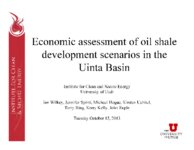TO
Filters: Format: "application/pdf" Research Institute: "Institute for Clean and Secure Energy (ICSE)" Collection: "ir_eua" Type: "Text"
| Title | Date | Subject | Description | ||
|---|---|---|---|---|---|
| 201 |
 |
Digitized log file, Utah Geological Survey Well Number U111 | 2009 | This log was digitized by the Utah Geological Survey from image files (.tiff) compiled by the Utah Division of Oil, Gas, and Mining | |
| 202 |
 |
Digitized log file, Utah Geological Survey Well Number U138 | 2009 | This log was digitized by the Utah Geological Survey from image files (.tiff) compiled by the Utah Division of Oil, Gas, and Mining | |
| 203 |
 |
Digitized log file, Utah Geological Survey Well Number U149 | 2009 | This log was digitized by the Utah Geological Survey from image files (.tiff) compiled by the Utah Division of Oil, Gas, and Mining. | |
| 204 |
 |
Digitized log file, Utah Geological Survey Well Number U153 | 2009 | This log was digitized by the Utah Geological Survey from image files (.tiff) compiled by the Utah Division of Oil, Gas, and Mining. | |
| 205 |
 |
Diluent-assisted hot-water processing of tar sands | 1987 | hot water processing; tar sands; diluent-assisted hot-water processing; bitumen viscosity | The influence of diluent addition and temperature on bitumen viscosity of tar sands from nine locations in the U.S.A. and Canada has been investigated. Subsequently, hot-water bitumen-recovery experiments were carried out at temperatures from 33°C to 95°C. Kerosene was added as needed to maintain ... |
| 206 |
 |
Dilution centrifuging of bitumen froth from the hot water process for tar sand | 1983-05-17 | Patent; Dilution centrifuging; Bitumen froth; Tar sand; Naphtha-diluted bitumen froth | In the known operation wherein naphtha-diluted bitumen froth is pumped from a scroll-type centrifugal separator to a disc-type centrifugal separator, an improved pumping system is provided. The system comprises at least two centrifugal pumps in series, each operating preferably at an impellor tip sp... |
| 207 |
 |
Domestic tar sands and potential recovery methods--a review | 1969-12 | The purpose of this paper is to review and evaluate present knowledge of United States tar sands including physical properties, occurrence, reserves, and recovery methods. Tar sands are oil, bitumen, asphalt, tar, or petroleum-impregnated rock from which little hydrocarbon material is recoverable by... | |
| 208 |
 |
Double solvent extraction of organic constituents from tar sands | 1977-09-06 | Extraction of hydrocarbons from tar sands with a light naphtha/methanol solvent system results in rapid decrepitation of the tar-sand aggregate and separation of organic matter into three phases. Distribution of the extracted and non-extracted organic material is among the phases. The most desirable... | |
| 209 |
 |
Dow shale site tracer gas pressurization study | 1977-10 | Systems, Science and Software (S3) has developed tracer gas/ pressurization techniques necessary to determine critical media properties of underground regions. Application of this technology is especially relevant to analysis of an oil shale retort volume. During the period 7 July to 14 July 1977, a... | |
| 210 |
 |
Downhole hydraulic mining system | 1985-07-31 | Oil-bearing sands; Oil field; Wellbore; Downhole hydraulic mining system; California; Utah; Kentucky; New Mexico; Canada; Venezuela; Oil; Deposits; Strip mining | The downhole hydraulic mining system is designed to exploit deposits of oil-bearing sands that are not economically producible using current oil field or mining technology. In most cases, the hydrocarbon in the reservoir is too viscous to flow into the wellbore naturally and applications of heat (st... |
| 211 |
 |
Draft environmental impact statement on conversion of oil and gas leases to combined hydrocarbon leases, Tar Sand Triangle, Utah | 1984-07-16 | The Draft Environmental Impact Statement will provide the Regional Director, National Park Service, and State Director, Bureau of Land Management, with the necessary information to make a decision on whether existing oil and gas leases in Glen Canyon National Recreation Area and on adjacent BLM land... | |
| 212 |
 |
Earth Energy Resources corporate presentation | 2008-02-22 | Oil sands; Earth Energy; Ophus Process; PR Spring, Utah; Bitumen; Oil sand mining; Tailings ponds; Extraction processes; Utah; Water consumption; Athabasca, Canada; Vernal, Utah; Simplot Phosphate Mine | Forward looking statements--Earth Energy Resources, Inc.: This presentation and the Company's website referenced in this presentation contain forward-looking statements including expectations of future production and components of cash flow and earnings. Investors are cautioned that assumptions used... |
| 213 |
 |
Earth Energy Resources Inc. | 2006-09-21 | Uinta Basin; Oil sands; Athabasca; Tailings ponds; Water usage and supply; Emulsion treating; Concurrent Reclamation; Natural Gas; Process heating fuel; Infrastructure; Product transportation; Production issues; Ophus Process; Bitumen; Tar sand; Utah | Issues facing oil sand production: -Issues facing Athabasca producers -Likely issues facing Uinta Basin producers -Technology advancements will provide the keys to unlock the oil sands in the USA |
| 214 |
 |
Earth Energy Resources, Inc. oil sands production in Utah: Continued development | 2009-02-27 | Oil Sand; Utah; Hydrocarbon Energy Environmental Gap; HEEG; Earth Energy; Oil sand production; Ophus Process; Oil sand deposits; Bitumen extraction; Oil sand mining; EER Spring Mine Site; Vernal, Utah | Overview of Earth Energy Resources, Inc.'s continuing oil sands development activities in Utah, presented at the 2009 Western U.S. Oil Sands Conference by D. Glen Snarr, President & Chief Financial Officer, Earth Energy Resources, Inc. |
| 215 |
 |
Economic assessment of oil shale development scenarios in the Uinta Basin | 2013-10-15 | Economic assessment; Oil shale development; Uinta Basin; In situ; Ex situ | |
| 216 |
 |
Economic comparison of the thermal and hot-water process for recovery of oil from tar sands | 1978-11 | A comparison of the economics of the Hot Water and Thermal Process for recovery of oil from the tar sands at Sunnyside is presented using a plant size of 25,000 B/D of hydrocarbon products. The Thermal Process will require an investment of approximately $120,000,000. The product is a low viscosity f... | |
| 217 |
 |
Economic evaluation of oil shale and tar sands resources located in the state of Utah: Phase 1 | 1981-02-15 | Managing public lands for maximum social benefit is becoming an increasingly complex task. The growing need for domestically produced mineral raw materials and energy, and the conflicting interests over the use of public lands, have added new dimensions to the management issues. This report covers t... | |
| 218 |
 |
Economic evaluation of oil shale and tar sands resources located in the state of Utah: Phase 2 | 1982-10 | Technically accurate economic evaluation of Utah resources is essential to the future health of Utah's economy and for the sound management of Utah's lands and mineral/hydrocarbon resources. This report presents the results of the second year of research aimed at resources in the State of Utah. The ... | |
| 219 |
 |
Economic impacts of U.S. liquid fuel mitigation options | 2006-07-08 | Oil; Oil shortages; United States dependence on oil imports; Energy Security; Vehicle fuel efficiency (VFE); Coal liquefaction; Coal-to-liquids (CTL); Oil shale; Enhanced oil recovery (EOR); Oil peaking; Liquid fuels | The world is consuming more oil than it is finding, and at some point within the next decade or two, world production of conventional oil will likely peak. Peaking will lead to shortages and greatly increased prices and price volatility. In addition to peaking and its consequences, there are widespr... |
| 220 |
 |
Economic potential of state-owned lands in the Sunnyside Special Tar Sand Area Carbon County, Utah | 1985 | The Sunnyside oil-impregnated (tar sand) deposit is located in the southwestern portion of the Uinta Basin, approximately 25 miles east of Price, Utah (fig. 1). The tar sands are located in the Wasatch Formation and in the Douglas Creek Member of the Green River Formation, with up to 32 individual b... | |
| 221 |
 |
Economic potential of the P.R. Spring oil-impregnated deposit, Uinta Basin, Utah | 1984-08 | The P.R. Spring oil-impregnated sandstone (tar sand) deposit is located in the southeastern portion of the Uinta Basin, approximately 50 miles northwest of Grand Junction, Colorado. These oil impregnated sandstones are in the Eocene Green River Formation and five zones have been identified. These zo... | |
| 222 |
 |
Ecoshale: Environmental alternative fuels | 2008-11-13 | Unconventional fuel; Oil industry; Oil shale; Utah; Colorado; Wyoming; Tar sand; Red Leaf; Duchesne County; Uintah Basin; Carbon County; Emery County; Grand County; Ecoshale; In-capsule process; Kerogen; Alternative Fule; Environmental; In-capsule; Economic | |
| 223 |
 |
Effect of ethanol on the chemical structure of the soot extractable material of an ethylene inverse diffusion flame | 2007 | Soot extractable material; Ethylene inversion diffusion flame; Aromatic fused rings; Neat flame; Chloroform-extractable material; Aliphatic component; Incomplete combustion; Fossil fuels; Ethanol; Soot; Emission; Soot particles; Polyaromatic hydrocarbons; Potential carcinogen | The effect of fuel-side ethanol addition on the chemical structure of the soot extractable material generated in an ethylene inverse diffusion flame was evaluated by means of average structural parameters. The results indicate that the ethanol effect on the aromatic components was more pronounced, w... |
| 224 |
 |
Effects of partial pressure of oxygen on the stability of axial, oxy-coal, turbulent diffusion flames: Topical report task 8 | 2009-07-31 | Oxy-fuel combustion; Pulverized coal; Flue gas recirculation; CO2 sequestration; Near-burner zone environment; O2; CO2; Partial pressure of oxygen; Flame stability; Air combustion; Coal-jet ignition models; Predicting flame attachment; Retrofit; Oxy-coal combustion; Type 0 axial flames; Turbulent di... | Oxy-fuel combustion of pulverized coal with flue gas recirculation is potentially one of the few technologies that may allow CO2 sequestration technologies to be applied to existing coal-fired boilers. One issue of interest is to understand and predict the effects of the near-burner zone environment... |
| 225 |
 |
Efficient parallelization of RMCRT for large scale LES combustion simulations | 2011-06 | monte carlo; RMCRT; parallelization; large scale LES combustion; combustion simulations; radiation | At the high temperatures inherent to combustion systems, radiation is the dominant mode of heat transfer. An accurate simulation of a combustor therefore requires precise treatment of radiative heat transfer. This is accomplished by calculating the radiative-flux divergence at each cell of the discr... |
